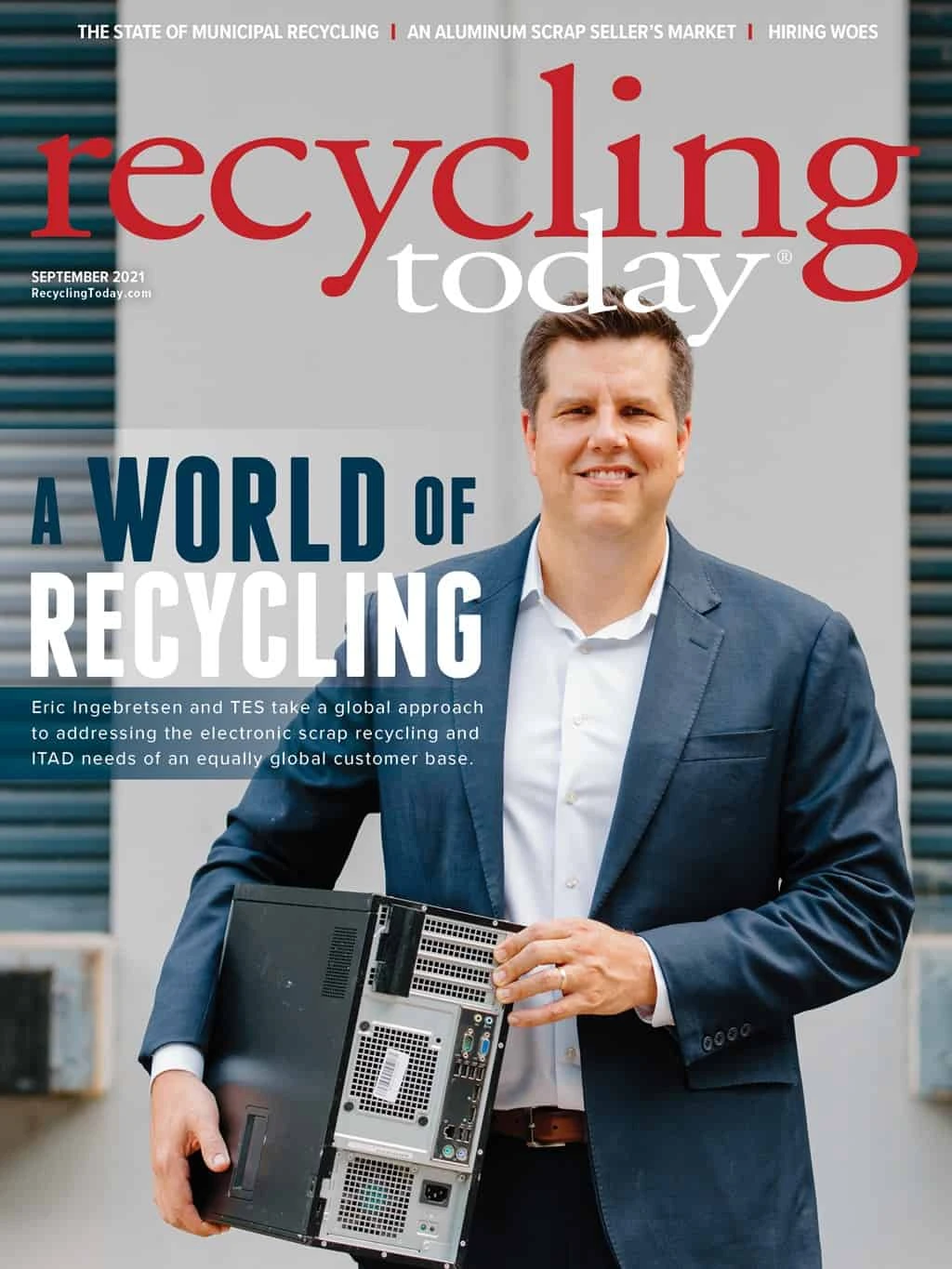
© interstid / stock.adobe.com

In the past 18 months, workers around the globe have faced immense challenges and pressures arising from the COVID-19 pandemic, the economic downturn and uncertainty about the future. Mental health is not a new challenge in the workplace, but it certainly has been brought to the forefront by the pandemic and can present safety, efficiency and team morale challenges.
For frontline and essential workers, which include personnel in the solid waste and recycling industry, this issue is even more urgent since going to work has presented additional challenges and risks. Even during shelter-in-place orders, industry workers were still going to work throughout 2020 and beyond, unsure about the risk of exposure to themselves and their families. They were in close contact with waste materials and recyclables as well as with members of the public and co-workers. These workers also might have had to work longer hours to cover shifts for those who were out sick or quarantining.
According to Centers for Disease Control and Prevention (CDC) data, only 11 percent of U.S. adults reported experiencing symptoms of anxiety or depression in 2019. Similar data the CDC gathered between April 2020 and February 2021 found that statistic jumped to 38.1 percent.
In an industry that focuses on physical and mental strength, people can be hesitant to discuss mental health issues at the risk of seeming “weak” or “incapable.” Historically, physical injuries or illnesses have been given priority over mental health issues. Sick days are common at many organizations, but few offer mental health days. Mental health is sometimes less visible than physical injury or illness, but it can have just as much of an impact, especially in terms of safety and distraction.
Undiagnosed and/or untreated mental health issues can compound into issues with substance abuse, domestic abuse or risk of harm to oneself or others. According to the National Council on Alcoholism and Drug Dependence, more than 70 percent of individuals abusing illicit drugs and alcohol in the U.S. are employed.
Substance abuse can lead to high absenteeism, lower job productivity and performance and greater health care expenses for injuries and illnesses. Safety risks related to substance abuse also can increase workers’ compensation and disability claims.
Mental health issues that go unchecked can lead to serious safety risks. Think about the focus required to operate a collection vehicle or another piece of heavy equipment. There are numerous controls, as well as blind spots and obstacles to avoid. For heavy equipment operators, often people, vehicles and other equipment are in proximity. Being distracted by stress in their personal lives or being under the influence could severely affect a worker’s ability to do his or her job safely.
Different types of stress
Stress, anxiety, trauma, depression and emotional upheaval in employees’ personal lives can affect their decision-making, distraction level and, ultimately, their safety. A divorce, the death of a loved one, illness or a financial crisis can follow employees to work and seriously affect their concentration. But not all stress is negative.
There are different types of stress, says Karen Johnson, a principal at Washington-based Trauma-Informed Lens Consulting. Positive stress is the mild stress that comes from everyday life and work. Short-lived stress responses can be helpful for healthy development by challenging the brain and helping workers push past their comfort zone. The key is that it’s “short-lived.”
This is not chronic, ongoing stress but the normal, everyday stress of waking up, going to work, working and managing life.
The next level of stress is tolerable stress. It is more severe than positive stress but is still limited in duration. This is the stress that happens when faced with a deadline, a new challenge at work or a temporary schedule shift. It doesn’t last forever, which means there is a chance for recovery.
Toxic stress is the final level and is defined as the extreme, frequent or extended activation of the body’s stress response without a break or support from others. For some people, the past 18 months of the COVID-19 pandemic is an example of toxic stress, where the ongoing uncertainty and risk has not been alleviated.
Obviously, the best scenario would be to minimize time in the more intense levels of stress, but real life doesn’t always allow for that. The key is to find ways of regulating stress response, even when dealing with levels of tolerable or toxic stress.
It starts at the top
Prioritizing mental health must start at the top of the organization and be integrated into the overall culture. The focus on toughness over vulnerability is a mindset that takes time to shift. Managers and employees need to understand that mental health issues can affect anybody, regardless of how strong and tough a person might seem. Managers must work to create a positive culture that prioritizes physical, emotional and psychological safety for all.
Management should model vulnerability and transparency to employees, so workers know that mental health discussions are not taboo topics. Conversations about mental health and addiction are never easy to have, but the more those topics are interwoven into a company’s safety and employee training programs, the less awkward they become.
Regulating stress
Regulation strategies are tools that allow people to manage their stress response. Bruce D. Perry, author of the book What Happened to You? Conversations on Trauma, Resilience, and Healing, says regulation strategies give people the ability to put time and thought between feelings and actions.
Many different types of regulation strategies are available, including things like open-door policies and communication with management, stretching, breathing or just simply taking a mental break. Every person has a unique response to stress and, thus, might need to create a unique set of regulation strategies.
Just as normalizing conversations about mental health is important, managers also should normalize stress-coping strategies to remain calm when under pressure and show empathy for employees or other managers who are struggling with mental health, anger or other emotional issues.
Managers can provide employees with a “toolkit” of strategies that employees can mix and match. Starting the day with a safety tailgate meeting and a few moments of breathwork can help introduce new strategies in a natural way. Employees might need to be reminded to revisit their regulation strategies throughout the day when facing stressful situations.
Managers also can work to build a network of mental health support within the organization and have employees check in on each other. Providing opportunities for employees to have a “time out” or a reset, perhaps during break or lunchtime, can help remind employees to prioritize their mental health.
38.1
percentage of U.S. adults who experienced symptoms of anxiety or depression between April 2020 and February 2021 based on Centers for Disease Control and Prevention data
During regular safety training or daily tailgate meetings, topics related to mental health and regulation strategies can be integrated into other topics. A manager also could invite guest speakers—ideally, people from the community who are experienced with treating or diagnosing mental health issues—to offer their perspectives.
When uncertainty is present—whether around a global pandemic or organizational changes—it is imperative that managers remain open and honest to be a trusted source for employees.
Policies and practices
Once managers have done the work to normalize mental health, the next step is integrating mental health strategies and conversations into the overall organization. Managers should understand the difference between chronic, serious depression or other mental health issues and the day-to-day management of stress that can help alleviate short-term anxiety.
When creating policies and practices around mental health, managers should ensure they are flexible and can adapt to new challenges.
If employees have access to mental health services through the organization’s health insurance or employee assistance programs, managers should ensure employees are aware of the available options. If the organization currently does not offer mental health services, managers might want to consider adding them, or at the very least, having a list of local resources to provide to employees who need mental health support. By promoting early access to mental health services and care, managers can help prevent more extensive issues down the road.
Policies always should be created in conjunction with the human resources department and/or union organizations. Management also should be aware of medical confidentiality and laws related to the Health Insurance Portability and Accountability Act, or HIPAA. While providing support and open communication is within managers’ responsibilities, managers should not try to diagnose or treat employees and always should defer to mental health professionals.
If managers find that emotional conditions or stress are affecting an employee’s work performance, he or she might need to be switched to a less-demanding job for a while. The employee might need to seek help from a counselor, clergyperson, trained medical health professional or local support group.
When making an emergency response plan, management should build in mental health considerations. If employees suffer a loss of a family member or lose a home in a natural disaster, those situations will deeply affect work performance. By anticipating those challenges and providing cross-training, managers can help provide flexibility for employees who can’t come to work or need to work in a less stressful role.
Mental health must be an integral part of every organization’s culture and health and safety programs. It is a difficult and sensitive topic, but it’s one that is worthwhile to discuss. Not only will it help employees work safely, but it also quite literally can help prevent serious issues, such as addiction, domestic abuse and fatalities, whether from suicide or accidents.

Explore the September 2021 Issue
Check out more from this issue and find your next story to read.
Latest from Recycling Today
- Orion ramping up Rocky Mountain Steel rail line
- Proposed bill would provide ‘regulatory clarity’ for chemical recycling
- Alberta Ag-Plastic pilot program continues, expands with renewed funding
- ReMA urges open intra-North American scrap trade
- Axium awarded by regional organization
- Update: China to introduce steel export quotas
- Thyssenkrupp idles capacity in Europe
- Phoenix Technologies closes Ohio rPET facility





